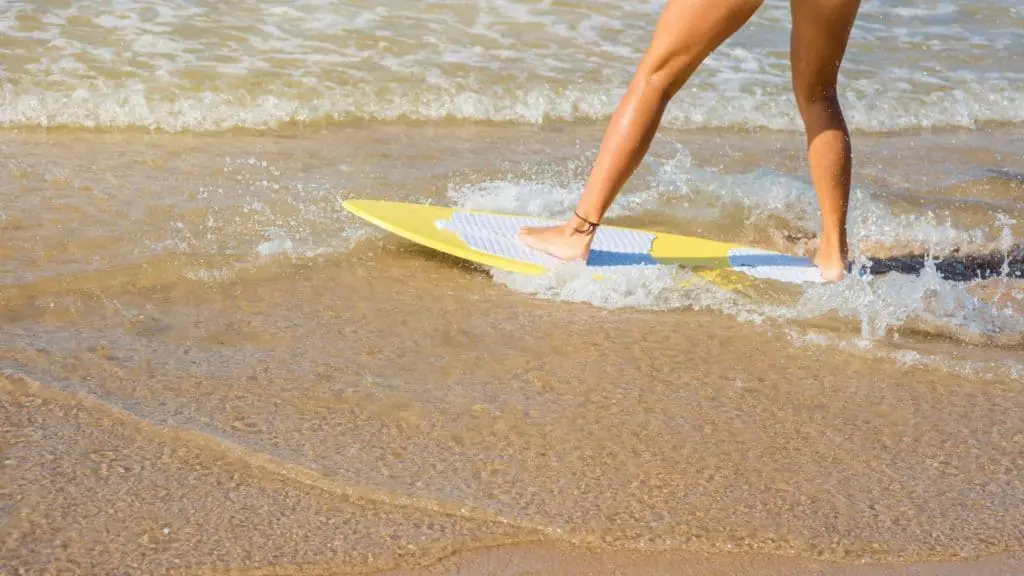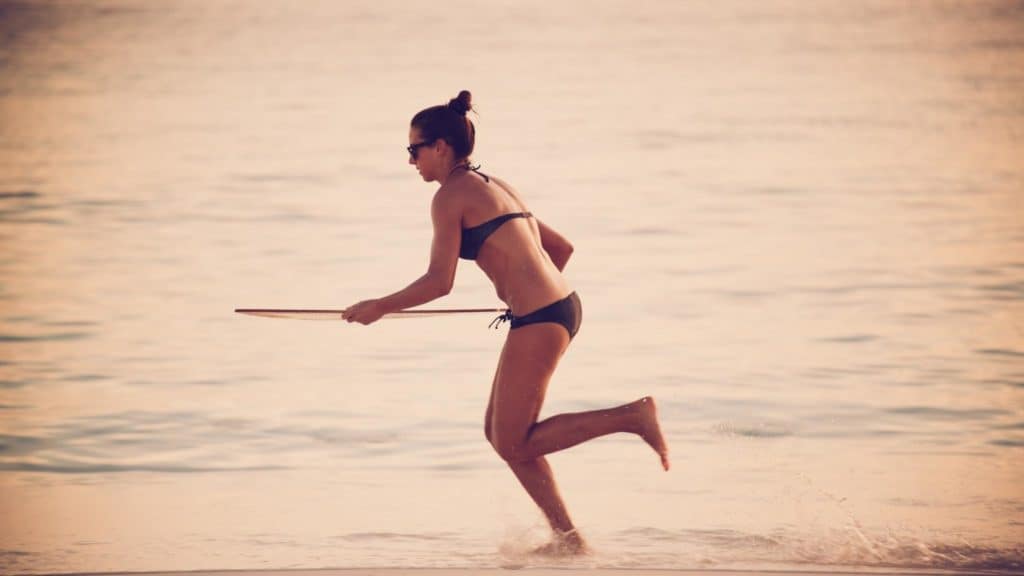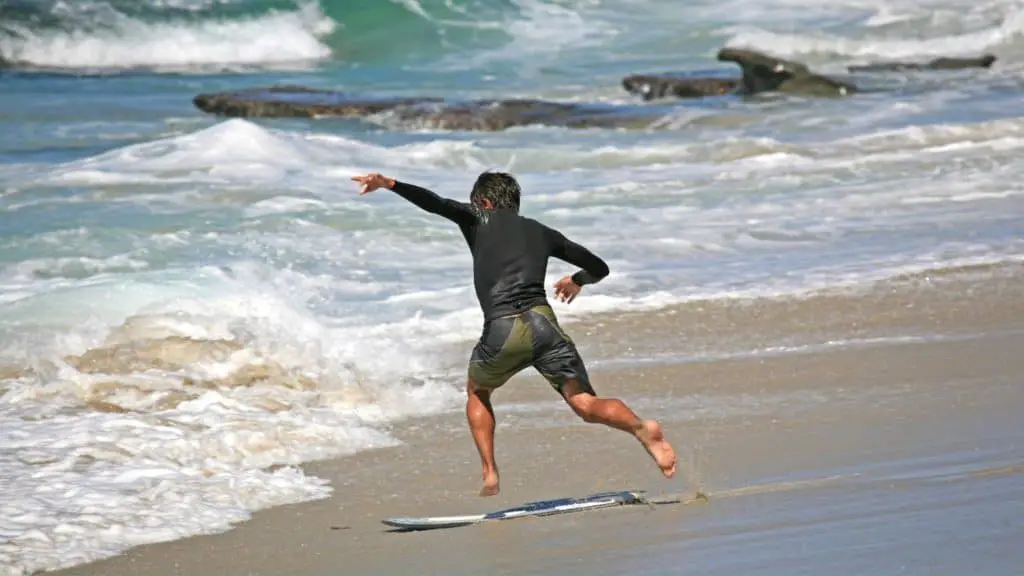Are you looking for a new summer hobby?
Skimboarding is a fun and easy way to enjoy the water, but it can be hard to get started, but once you get the hang of it, you can enjoy hours of fun on the water.
In this article, I’m going to teach you the basics of skimboarding. I’ll show you how to choose the right board, stand on it properly, and get started moving across the water. I’ll also give you some tips on how to improve your skills as you move towards becoming a kickass skimboarder.

If you’re looking for a new summer hobby that’s both challenging and exciting, skimboarding might just be the perfect fit.
But before you head out to your local beach or lake with your board in hand, it’s important to learn the basics.
In this post we'll cover:
- 1 What is skimboarding?
- 2 Is skimboarding hard?
- 3 The Basic skimboarding techniques
- 4 The right skimboard
- 5 How do you set up a skimboard?
- 6 How to Stand on the Board and Balance Yourself
- 7 How do you skimboard on water?
- 8 How do you ride waves on a skimboard?
- 9 Sand skimming on a flat beach
- 10 10 Tips for Improving Your Skills as a Skimboarder
- 11 How long does it take to skimboard?
- 12 Conclusion
What is skimboarding?
Skimboards are flat boards that you use for riding waves. The phrase “skim” means ” sliding without turning.
Initially, skimming was started at a life-saving rescue in 1920 at Laguna beach when George Griffeth and his friend Jimmy made rounded discs from red wood that glided through the ocean.
The 1960s were an early stage in an innovative surf-board that imitated smaller, bigger surfboards.
In its early stages, skimboarding was just a great alternative to flat surf days, but it gained the status of official watersport with time and is now a well known sport.
Is skimboarding hard?
Skimboarding can be quite difficult as a beginner with a steep learning curve:
– The board is difficult to balance on
– It’s hard to move across the water
– It takes a lot of practice to get good at it
– There are many different techniques to learn
– It can be frustrating when you’re just starting out
Skimboarding is so hard to learn because one of the most difficult things is getting and staying on the board, unlike other sports like skateboarding or snowboarding, where that first part is already covered.
Is skimboarding easy to learn once you get through the basics?
Yes, skimboarding is easy to learn once you get through the basics. Once you have mastered how to balance on the board and move it across the water, you can start learning more advanced techniques and tricks.
The Basic skimboarding techniques
Now that you know a little bit about skimboarding, let’s go over the basics of how to do it.
Practice throwing your board
Before you head to the beach, it’s important to practice throwing your board on the ground. This will help you get comfortable with how the board feels and how to hold it.
How to hold a skimboard
When you’re holding the board, you want to make sure that you hold the board flat and parallel to the ground. This will help you get started moving across the water more easily.

You hold the skimboard next to your body on the right side when running, with your right hand at the back of the board, on the side farthest away from your body, and your left hand on the front of the board, on the side closest to your body.
This is for right handed people, lefties can change hands.
How do you throw the skimboard?
To throw the skimboard, hold it with your non-dominant hand and use your dominant hand to give it a good shove.
You do this while running to gain speed so start running towards shallow water.
You need to drop your board more than throw it. It’s essential that you keep the board parallel to the ground when dropping it. This is one of the harder things to execute correctly.
How do you get on a skimboard?
Quickly run towards the water and jump on the board as it hits the water. Try to land as close to the front of the board as possible.
Land with your front foot first, pointing towards the direction you’re going, then the best thing is to push off with your back foot (probably your right foot) to gain extra speed.

Then place your back foot across the back of the board and push down pretty hard to keep the nose of the board from going under water.
Once you’re on the board, focus on keeping your balance. Keep your body low to the board and use your hands to help you balance.
You need to have bare feet when skimboarding mind you, because you need the traction your foot gives you on a traction pad or wax.
The right skimboard
Let’s look at skimboards for beginners and what to look for when buying one.
How to Choose the Right skimboard
When choosing a skimboard, you want to make sure that it’s the right size and shape for you. It all depends on what type of skimming you’re going to do.
What skimboard is good for beginners?
The best skimboard for beginners is a small, round board. It will be easier to balance on and move across the water.
As a beginner, it’s probably best to use a foam board, as they are easier to get on and keep above the water. You’ll have a better experience in your first few tries of skimming.
Plus, the soft foam keeps your ankles from being hurt by the hard surface of carbon-fiber and wooden boards.
A good beginner’s board is a soft, round foam board. It will be easy to balance on and move across the water.
As you progress in your skills, you can move on to a wooden or carbon fiber board. But it’s always a good idea to have a soft board for practicing and for beginners.
Check out these best skimboards from beginners to more advanced
What size skimboard is best for beginners?
A good size for a beginner is around 28-30 inches. This will give you plenty of control and stability as you’re starting out.
As you progress in your skimboarding skills, you can move on to a bigger board. But it’s always best to start small and work your way up.
The round shape of the board will help you move smoothly across the water.
Are wooden skimboards good for beginners?
Some people prefer wooden boards over other materials like foam, carbon fiber, and plastic.
Wooden boards are a good option for beginners because they are more durable and can withstand more wear and tear. They are also a little heavier than other materials, which can help you stay on the board in choppy water.
There are some pretty cheap wooden models out there so that’s a plus if you don’t know if you want to pursue this sport yet.
How do you set up a skimboard?
You don’t need to do much to your skimboard to be ready to take it out and ride, but you do need some grip on the surface if you’re going to ride in the water.
This can be either by applying skimboard traction pads if you don’t have any on there yet, or some surf wax.
A traction pad offer better grip than a thin layer of wax would so you might want to invest in some after you know you want to skim board further.
How do you wax a skimboard for the first time?
Cleaning your board after every use is a great way to keep it in top condition. If you have old wax on there, the first thing that needs doing? Clean off!
Waxes are applied using friction from water, so cleaning will help remove all dirt and oils on top which could cause a buildup if not taken care off quickly enough!
After cleaning the surface off with soap water then applying a light coat tropical Surfboard Wax (or any other type), grabbing some top coat if needed and then temperature rated Skimboard wax.
Make sure to keep reapplying new layers every so often when you’re skimboarding regularly.
How to Stand on the Board and Balance Yourself
Now that you have your skimboard, it’s time to learn how to stand on it!
When you’re starting out, it’s best to do this on land. This will help you get the hang of balancing on the board.
To stand on the board, place your feet in the middle of the board with your toes and heels together.
Then, lean your weight onto one foot and lift the other foot up so that you’re standing on the board.
Make sure to keep your knees bent and your body centered over the board.
How do you skimboard on water?
Once you’ve mastered standing on the board, it’s time to try it out in the water.
Start by getting into the water and facing the shore.
Then, place your lead foot (the one closer to the shore) in front of the board and your back foot slightly behind it.
Next, lean your weight onto your lead foot and lift your back foot up.
Make sure to keep your body centered over the board.
Now, it’s time to push off with your lead foot and start skating across the water!
Remember to always keep the nose above the water or you’ll lose speed and come to a complete stop.
How do you ride waves on a skimboard?
Once you’ve gotten the hang of skimboarding on flat water, it’s time to try out some wave skimming!
Start by finding a wave that is a good height in the shore break and run out towards it.
When you’re on a beach with a powerful shore break, finding breaking waves shouldn’t be hard, so now it’s down to timing.
Drop your board in the water in front of the wave, jump on it and skim towards the wave.
You can just kind of jump over the wave and maybe try a trick like shove its while your in the air, but the best way to enjoy the wave is to turn and start riding the wave like a surfer would.
Before long, you’ll have your first wave under your belt and are well underway to some wave riding on big waves.
Sand skimming on a flat beach
What about sand skimming on flat sand?
While there’s no set way to do this, beginners usually start by finding an area with a lot of sand and then run along the water.
Wet sand and speed can make it so you can skim along the beach, even without getting into the water, and this can make a perfect training session to get a feel for it.
Watch out for other skimmers though as it might be hard to control where you’re going.
10 Tips for Improving Your Skills as a Skimboarder
So you’ve got the basics down, but want to take your skills to the next level? Here are some tips for improving your skimboarding skills:
1. Practice on flat water – This will help you get a better sense of balance and control on the board.
2. Try different stances – Experiment with different stances to see what feels the most comfortable and helps you move the fastest.
3. Practice your tricks – The more you practice, the better you’ll become at doing tricks.
4. Ride waves – Once you’ve got the basics down, try riding waves for a more exciting experience.
5. Skim on sand – If you’re having trouble staying on the board in the water, try skimming on the sand.
6. Use a smaller board – If you’re just starting out, it might be helpful to use a smaller board until you get the hang of it.
7. Wear a wet suit – A wet suit will help keep you warm and can make it easier to keep practicing in cold water.
8. Watch videos of pro skimboarders – Seeing how the best do it can help give you some ideas on how to improve your own skills.
9. Find a skimboarding buddy – Having someone to practice with and learn from can be a huge help.
10. Practice, practice, practice! – The more you practice, the better you’ll become at skimboarding.
How long does it take to skimboard?
It really depends on the person. Some people might take a little while to get the hang of it, while others might be able to pick it up immediately.
With practice, most people can become fairly skilled skimboarders in a relatively short amount of time.
Conclusion
Skimboarding is a great activity for people of all ages and skill levels. Start by practicing on flat water before moving onto waves, sand skimming or any other tricks you want to try.
It’s important to also take care of your body while skimboarding with the right equipment (wet suit) and enough breaks in between sessions so that it doesn’t get too tiring.
With a little bit of practice, anyone can become a skilled skimboarder!
